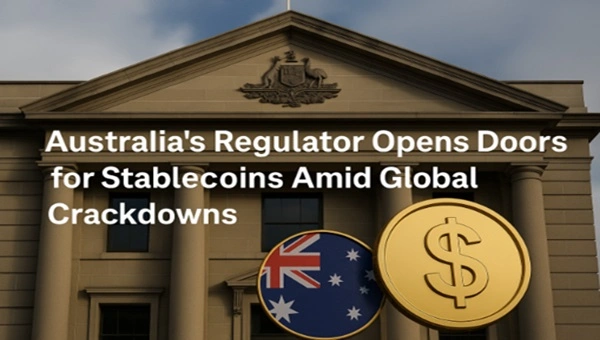
Effective September 18, 2025, intermediaries that distribute stablecoins issued by firms already holding an Australian Financial Services (AFS) license no longer need to obtain separate licenses for activities such as dealing, custody, or financial advice. The exemptions apply to secondary distribution and custodial services and currently cover only the AUDM stablecoin issued by Catena Digital Pty Ltd. ASIC indicated that the framework will expand as additional licensed issuers qualify, creating scope for wider integration across payment platforms and tokenized asset markets.
The changes follow consultation that began in December 2024 under Consultation Paper 381, which reviewed the treatment of stablecoins under the Corporations Act. ASIC emphasized that while licensing relief reduces duplication, consumer protections remain. Intermediaries are required to provide product disclosure statements to clients, and the exemptions are temporary, expiring on June 1, 2028. By that date, a comprehensive payments framework for stablecoins is expected to take effect.
A New Regulatory Framework for Stablecoins
Industry participants have long argued that duplicative licensing requirements inflated costs and limited innovation. Analysts estimate that eliminating redundant approvals could reduce operating expenses for mid-tier exchanges and custodians by up to 30 percent. Smaller firms, often constrained by high compliance overheads, stand to benefit most from the relief. Larger exchanges are also expected to expand their stablecoin offerings, increasing competition in digital payments.
Catena Digital’s AUDM is the first stablecoin to benefit. Pegged to the Australian dollar and backed by reserves held in domestic banks, AUDM aims to provide a compliant alternative to global stablecoins such as USDT. The new exemptions give intermediaries a clearer path to distribute and hold AUDM without the burden of full licensing requirements, provided disclosure obligations are met. ASIC’s backing of tokenization pilots earlier this year, including Project Acacia, demonstrated the regulator’s interest in supporting blockchain applications in mainstream payments and settlement.
Fintech associations noted that the changes could accelerate integration of stablecoins into wallets, remittance services, and cross-border payment systems. Australia’s fintech sector, with more than 800 active firms, is expected to see increased activity from ventures focused on stablecoin solutions.
Australia’s Approach vs. Global Trends
The timing of ASIC’s decision sets Australia apart from other jurisdictions that are tightening rules. On September 16, 2025, Israeli authorities announced that they had identified 187 cryptocurrency wallets allegedly linked to Iran’s Islamic Revolutionary Guard Corps. The wallets, primarily on the Tron blockchain, were said to have processed around 1.5 billion dollars in USDT. Israel called on Tether to freeze the assets as part of national security enforcement.
Such incidents have reinforced concerns that stablecoins can be used to bypass sanctions. Blockchain analytics firms, including Elliptic, have previously traced similar flows tied to designated groups. These findings have pushed the European Union and the United States to adopt stricter measures. The EU’s Markets in Crypto-Assets (MiCA) framework, fully enforced by mid-2025, imposes transparency and reserve requirements on issuers. The U.S. Treasury has expanded sanctions targeting crypto networks linked to adversarial states.
Australia has chosen a different approach, balancing oversight with encouragement of domestic innovation. By linking relief to licensed issuers under existing financial law, ASIC has maintained regulatory visibility while reducing compliance friction. The structure resembles frameworks in jurisdictions such as the United Arab Emirates, where pilot programs and sandboxes have enabled controlled adoption of stablecoins.
The decision also reflects lessons from earlier failures in the sector. The collapse of Terra-Luna in 2022 and the subsequent FTX insolvency highlighted risks linked to weak reserves and inadequate supervision. Critics argue that reducing licensing requirements could increase consumer exposure if issuers mismanage reserves or face liquidity pressures. ASIC counters that its framework ensures only supervised entities benefit from the exemptions and that broader reforms will introduce further protections.
What does this mean for Australia’s Fintech Sector?
Industry projections suggest that stablecoin transaction volumes in Australia could triple by 2027, driven by integration into remittance channels and supply chain finance. Analysts also expect stablecoins to play a role in tokenized securities and real-world asset platforms, areas where Australian firms have already begun experimenting. If the exemptions succeed in lowering costs while maintaining safeguards, the country could strengthen its position as a hub for digital asset development in the Asia-Pacific region.
For now, the exemptions give domestic players breathing room to scale operations while longer-term rules are finalized. With international regulators adopting more restrictive positions, Australia’s stance signals a willingness to back licensed innovations while global debates on stablecoins continue.
He has worked with several companies in the past including Economy Watch, and Milkroad. Finds writing for BitEdge highly satisfying as he gets an opportunity to share his knowledge with a broad community of gamblers.
Nationality
Kenyan
Lives In
Cape Town
University
Kenyatta University and USIU
Degree
Economics, Finance and Journalism


Facts Checked by Will Wood



 Fact checked by
Fact checked by 
 eabungana@gmail.com
eabungana@gmail.com 